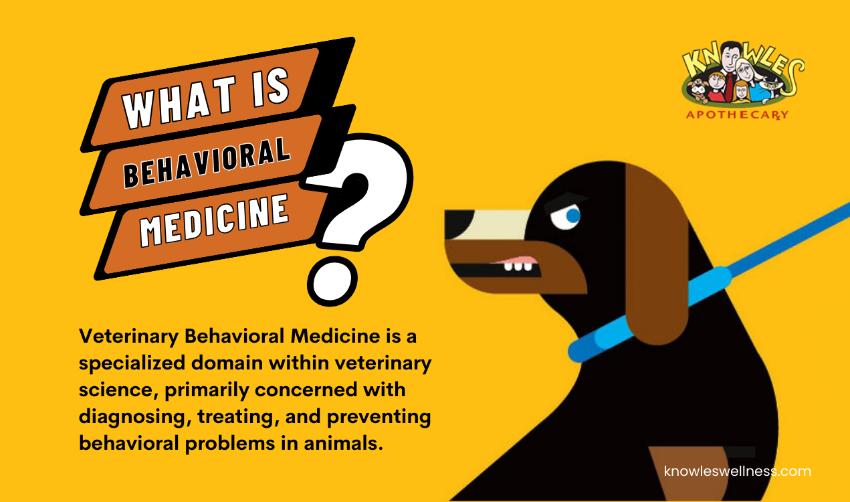Evolving to the landscape of veterinary care, a new and dynamic thread is emerging, capturing the attention of both pet owners and veterinary professionals. This burgeoning discipline, known as Veterinary Behavioral Medicine, offers an in-depth understanding of animal behavior, coupled with innovative solutions that extend beyond traditional veterinary practices. In this article, we delve into the nuances of this fascinating field, highlighting its significance, methodologies, and its profound impact on the lives of pets and their human companions.
What Is Veterinary Behavioral Medicine?

Veterinary Behavioral Medicine is a specialized domain within veterinary science, primarily concerned with diagnosing, treating, and preventing behavioral problems in animals. As per authoritative resources like the MSD Veterinary Manual and the European College of Animal Welfare and Behavioural Medicine (ECAWBM), this field transcends symptomatic management, aiming to uncover and address the root causes of behavioral issues.
Pets exhibit a spectrum of behavioral problems, ranging from common concerns like excessive barking or litter box issues to more serious conditions such as aggression or acute anxiety. These behaviors are not merely disruptive but are often manifestations of deeper physical or psychological distress. Veterinary behavioral medicine approaches these issues through a comprehensive blend of medical, environmental, and behavioral strategies.
The Growing Importance of Behavioral Medicine in Veterinary Care

The rising prominence of this field is a reflection of the evolving bond between humans and their pets. In modern households, pets are considered integral family members, and their mental and emotional well-being is as crucial as their physical health. Understanding and managing behavioral issues is essential for a harmonious coexistence.
Significantly, behavioral problems are a leading cause of the relinquishment or euthanasia of pets. Effective management of these issues is not just about improving the quality of life for the animals; it’s about fostering strong, enduring human-animal bonds.
Understanding the benefits of veterinary pharmacy services is crucial for pet owners, as these services play a key role in the holistic approach to addressing behavioral issues, offering tailored medication solutions that complement behavioral therapies.
In-Depth Approaches in Veterinary Behavioral Medicine
Veterinary Behavioral Medicine stands at the crossroads of various scientific disciplines, blending aspects of veterinary science, animal behavior, psychology, and neurobiology.
This multifaceted approach allows professionals in this field to address the complexities of animal behavior through a variety of techniques and strategies.
1. Behavioral Assessment

This step is foundational in Veterinary Behavioral Medicine. It involves a detailed and holistic examination of an animal’s behavior, medical history, and environment. This assessment is not just a surface-level observation of the animal’s actions but delves into the pet’s daily routine, interactions with humans and other animals, and any past traumas or medical issues. The environment is also closely scrutinized, considering factors like living space, daily routines, and potential stressors. This thorough evaluation is crucial in identifying the root causes of behavioral problems, allowing for more targeted and effective interventions.
2. Medical Intervention

It’s a common misconception that behavioral problems are always rooted in psychological issues. However, many behavioral changes can be symptomatic of underlying medical conditions.
For example, a cat that suddenly stops using the litter box might be suffering from a urinary tract infection, or a dog that becomes aggressive might be experiencing chronic pain. Treating these underlying medical conditions can have a transformative effect on an animal’s behavior. Veterinary professionals work closely with pet owners to ensure that any physical health issues are comprehensively addressed, often leading to significant improvements in behavior.
3. Behavior Modification Techniques

These techniques are the cornerstone of treatment in Veterinary Behavioral Medicine. Customized strategies are developed for each animal, tailored to their specific needs and behaviors. This might involve positive reinforcement training to encourage desirable behaviors, desensitization exercises to reduce fear or anxiety responses, or cognitive-behavioral therapy to alter the way pets perceive and react to certain stimuli. The aim is to modify the pet’s behavior in a way that is both humane and effective, often involving changes in the pet’s environment or routine to support these behavioral adjustments.
4. Pharmacological Support

In some cases, behavior modification techniques alone are not sufficient, especially for behaviors that are rooted in anxiety or other deep-seated psychological issues. Here, pharmacological intervention becomes necessary.
Medications can be used to manage symptoms of anxiety, depression, or aggression, providing much-needed relief for the animal. These medications are carefully prescribed and monitored by veterinary professionals, ensuring they are used appropriately and effectively, often in conjunction with other behavioral therapies.
To get a clearer picture of the pharmacological options available, pet owners can explore a list of 7 common dog medications often prescribed in cases where behavior modification needs a medical supplement.
5. Owner Education and Involvement

Perhaps the most critical aspect of Veterinary Behavioral Medicine is the involvement and education of pet owners. Successful treatment of behavioral issues is heavily reliant on the owner’s understanding and participation. Veterinary professionals spend considerable time educating pet owners about their pet’s condition, the rationale behind prescribed treatments, and how to effectively implement behavior modification techniques at home.
This collaborative approach not only empowers pet owners but also ensures that the treatment strategies are consistently applied, significantly increasing the likelihood of successful outcomes. For pet owners looking to further understand and address their dog’s behavioral issues, a comprehensive dog behavior training guide can provide valuable insights and practical tips, complementing the strategies discussed in Veterinary Behavioral Medicine.
The Future Prospects of Veterinary Behavioral Medicine
The horizon of Veterinary Behavioral Medicine is expanding rapidly, with future prospects promising a revolution in how we understand and treat animal behavior. Advances in technology and research are expected to lead to more precise diagnostics and personalized treatment plans. The integration of genetic testing, for example, could help predict susceptibility to certain behavioral conditions, allowing for early intervention. Moreover, innovations in brain imaging and neurobiology could provide deeper insights into the neurological underpinnings of behavior, opening new pathways for treatment.
There is also a growing emphasis on the integration of Veterinary Behavioral Medicine into routine veterinary care. This holistic approach acknowledges the interplay between physical and mental health in animals. In the future, veterinary practices might routinely include behavioral assessments in regular check-ups, ensuring early detection and management of potential issues. Additionally, there will likely be a greater collaboration between veterinary behavioral specialists and traditional veterinarians, enhancing the overall quality of animal healthcare.
Furthermore, the field is expected to benefit from increased public awareness and education. As society continues to recognize the importance of mental health for animals, there will be more demand for behavioral services. This public shift will encourage more research funding, better educational resources for pet owners, and the development of new therapies and medications. Ultimately, the future of Veterinary Behavioral Medicine is geared towards creating a world where the behavioral needs of pets are not just recognized but are an integral part of their overall care and well-being.
Conclusion
Veterinary Behavioral Medicine is more than a branch of veterinary science; it’s a conduit between understanding and empathy, blending science with compassion. It represents a holistic approach to animal health, underscoring the importance of behavioral health alongside physical health. For pet owners grappling with behavioral challenges in their pets, this field offers not just solutions, but a beacon of hope, ensuring the preservation of an unbreakable bond between them.
As the field evolves, staying informed about veterinary compounding laws is essential for both veterinarians and pet owners, ensuring that treatments for behavioral issues comply with the latest regulations and standards. As we continue to explore the depths of animal behavior, it becomes increasingly evident that Veterinary Behavioral Medicine isn’t solely focused on treating problems; it’s about enriching the lives of animals and those who love them.
For those interested in staying abreast of the latest developments in Veterinary Behavioral Medicine and overall pet wellness, visiting Knowles Apothecary veterinary services can provide a wealth of up-to-date information and resources.


